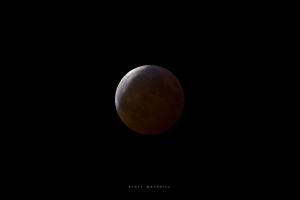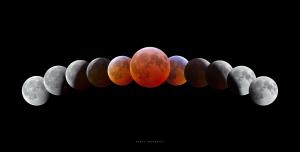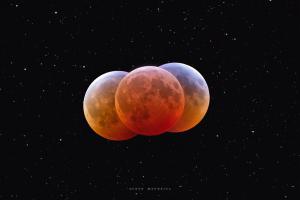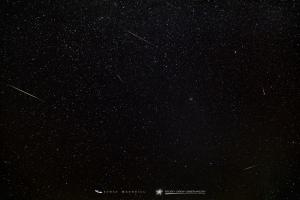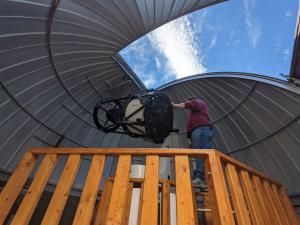Celebration of Space - November 12, 2021

The maximum eclipse stage of the January 2019 total lunar eclipse. Image credit: Frosty Drew Astronomy Team member Scott MacNeill
Last week we wrote about Comet C/2021 A1 Leonard, and the prospects for it to become naked-eye visible in the early morning sky. Well comet Leonard continues to increase in brightness, and will likely become easily visible in binoculars and small telescopes. The prospects of naked-eye visibility continue to increase as well. Once the comet passes Earth, and continues its journey toward perihelion (closest to the Sun), there is a possibility that Comet Leonard may become naked-eye-visible in the daytime sky due to a phenomenon called forward scattering. This will cause sunlight to scatter when encountering the comet’s dusty atmosphere (coma) in a manner that reflects sunlight towards Earth, making the comet appear much brighter than it actually is. In any case, Comet Leonard will be the brightest comet of 2021, and is going to put on some level of comet fantastication. Additionally, the comet will make a fabulous target for the new PlaneWave CDK600 telescope at Frosty Drew Observatory over the next month.
On Friday, November 19, 2021 an almost-total lunar eclipse will occur, with only a sliver of the Moon remaining in direct sunlight. Technically it’s a partial lunar eclipse. Nearly all regions of the United States will catch the entire eclipse, except New England, which will miss the very end of the eclipse. Though the part of the eclipse that we will miss is when the Moon exits Earth’s penumbra (secondary shadow), which is hardly noticeable anyway.
A lunar eclipse occurs when the Moon approaches the ecliptic during the full lunar phase. The ecliptic is the path that the Sun takes across the sky, and represents the plane of the Solar System. Earth’s Moon does not orbit Earth in relation to our equator, but instead orbits within 5.1° of the ecliptic. This is why the Moon appears very low in the summertime night sky and very high in the wintertime night sky. During a full lunar phase, the Moon, Earth, and Sun are in alignment with the Moon on the opposite side of Earth than the Sun. When the Moon is closer to the 5.1° distance above or below the ecliptic, sunlight will shine past Earth and illuminate the side of the Moon that faces Earth. But when the Moon is close to the ecliptic, part of the Moon will enter Earth’s shadow, creating a partial lunar eclipse. If the Moon is within about 1.25° of the ecliptic, then all of the Moon will enter Earth’s shadow, creating a total lunar eclipse.
During a total eclipse, refracted sunlight from Earth’s atmosphere will direct sunlight towards the Moon, which will subtly illuminate the lunar surface. But a process called Rayleigh Scattering, will only allow for red and some green light to make it to the Moon, with blue light staying in Earth’s atmosphere. This is because the blue side of the visible spectrum is scattered by atoms and molecules in Earth’s atmosphere causing the blue light to become polarized. This is why the daytime sky is blue. Depending on the contents of Earth’s atmosphere, green light can scatter as well. Events like large wildfires and volcanic eruptions can cause a lot of ash and smoke to circulate in the atmosphere, which will scatter green light. This is why the Moon appears to be a crimson red during a total lunar eclipse, with varying intensities. Sometimes the Moon is very red, while other eclipses will bring more of a ruddy hue to the Moon.
As for viewing the eclipse, you will have to be up very early in the morning on November 19th. The eclipse begins over our location at 1:02 am, with maximum eclipse happening at 4:04 am. During this time, one side of the Moon will take on a crimson hue. The eclipse will end for us at 5:47 am. Frosty Drew Observatory and Science Center will be open for the entire eclipse starting at 12:30 am and going until 7:00 am. Live views of the eclipse will be on screen in the Sky Theatre and Observatory, and we’ll have telescopes set up outside to observe the eclipse. Celestially speaking, everything is lined up perfectly for a stunning night, all we need now is for the weather to cooperate. Visit our event page for the eclipse.
Overnight Wednesday, November 17, 2021 the annual Leonid Meteor Shower peak will occur, bringing with it a meager 15 meteors per hour increase in regular meteor activity. That’s under perfect viewing conditions. But this year the Full Moon will accompany the Leonid peak, which will likely obscure all Leonid meteors. The Leonid peak is rather famous due to the intense display of thousands of meteors per hour in 2001. This happens every thirty – thirty five years, but not reliably. The reason for these outbursts are due to Earth orbiting through very dense regions of debris left behind by comet 55P/Tempel-Tuttle, where most of the time Earth passes through rather tenuous regions of the debris field. At Frosty Drew we are not big fans of the Leonid Meteor Shower peak as we usually see more Taurid meteors than Leonid meteors. As a side note, the rocket that is in the Frosty Drew Science Center, called Project Comet Chaser, traveled to space and into the tail of comet 55P/Tempel-Tuttle. For those who want to try to see the Leonid peak, you will want to be outside during the morning hours before sunrise. Lay on your back in a way that the Moon is out of your view, and see if you spot any shooting stars. If you end up empty handed, tired, and cold, you can’t say we didn’t warn you.
This past week, we wrapped up most of the PlaneWave CDK600 telescope configurations and calibrations and are moving the telescope into regular operations. With the inclement weather scheduled for tonight and tomorrow night, we will postpone our First Light Celebration until next weekend. Our plans for the First Light events are to host public access to the observatory both Friday and Saturday nights for three weekends. During the First Light events, we will leave the shroud off the telescope assembly, which will allow for easy viewing of the internal working components, at the cost of a little extra stray light. We also completed our time lapse compilation of the entire replacement project, which can be viewed on our YouTube channel. Check it out, it’s certainly worth a watch. Additionally, this video installment kicks off a new Frosty Drew YouTube series called A Frosty Drew Light Minute, which will see new installments every couple of weeks that are (usually) one minute in length. Each installment will showcase something about the Frosty Drew mission, or equipment, or just astronomical science in general, and will feature different members of the Frosty Drew Astronomy Team. Subscribing to our YouTube will get you notifications when new content is posted.
- Author:
- Scott MacNeill
- Entry Date:
- Nov 12, 2021
- Published Under:
- Scott MacNeill's Columns

